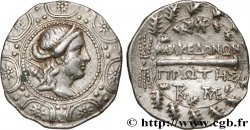bgr_946189 - MACEDONIA - AMPHIPOLIS Tétradrachme stéphanophore
Not available.
Item sold on our e-shop (2024)
Price : 1 200.00 €
Item sold on our e-shop (2024)
Price : 1 200.00 €
Type : Tétradrachme stéphanophore
Date: c. 150 AC.
Mint name / Town : Amphipolis, Macédoine
Metal : silver
Diameter : 30,5 mm
Orientation dies : 9 h.
Weight : 16,88 g.
Coments on the condition:
Exemplaire de qualité exceptionnelle sur un flan bien centré des deux côtés, un peu court sur le bouclier. Portrait magnifique de toute beauté où tous les détails de la chevelure sont visibles. Revers de haut relief, finement détaille. Merveilleuse patine de médaillier avec des reflets mordorés. Conserve l’intégralité de son brillant de frappe et de son coupant d’origine
Catalogue references :
Predigree :
Cet exemplaire provient du stock d’Alain Poinsignon (Strasbourg)
Obverse
Obverse legend : ANÉPIGRAPHE.
Obverse description : Buste diadémé et drapé d'Artémis Tauropolos à droite, l'arc et le carquois sur l'épaule, placé au centre d'un bouclier macédonien orné d'étoiles.
Reverse
Reverse description : Légende de chaque côté d'une massue ; au-dessus, un monogramme.
Reverse legend : MAKEDONWN // PROTHS// (AUR)
Reverse translation : (Macédoine première).
Commentary
Au revers, il faut bien lire le monogramme comme (AYP) et pas seulement (AP). Au droite, nous avons sept médaillons luni-solaires entourant le buste d’Artémis qui orne le bouclier.








 Report a mistake
Report a mistake Print the page
Print the page Share my selection
Share my selection Ask a question
Ask a question Consign / sell
Consign / sell
 Full data
Full data









